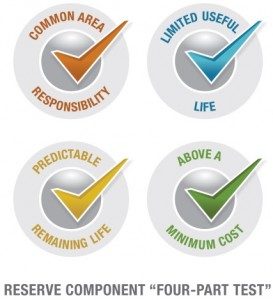A Reserve Study’s Component List
The Reserve Component List forms the foundation of every Reserve Study, detailing the scope and schedule of all anticipated Reserve projects. Reserve Fund Strength (also known as Percent Funded) and the Reserve Funding Plan are both calculated based on the repair & replacement projects that appear on the Reserve Component List. So it is very important that the Component List is complete, accurate, and stable.
Fortunately, what should (or should not) qualify as a Reserve budget line item is not a matter personal preference. It is also not based on a secret or proprietary checklist maintained by any one Reserve Study company to ensure that no components are “missed”.
Building the Component List: National Reserve Study Standards
Reserve Component List decisions rely on a four-part test defined in National Reserve Study Standards. To qualify for reserve budget funding, a component needs to pass all four of the four tests:
 Test #1: The component must be a common area maintenance responsibility
Test #1: The component must be a common area maintenance responsibility- Test #2: The component must have a limited Useful Life (UL).
- Test #3: The component must have a predictable Remaining Useful Life (RUL).
- Test #4: The scope of work must be above a minimum threshold cost.
Component List Tests Explained
So, what does all this mean?
Test #1 means that your Reserve components should not be derived from a generic master checklist. Reserve line items should be established based on a thorough understanding of the Association’s common area assets and maintenance responsibilities, as defined in the association’s governing documents or a well-established Association precedent.
Test #2 excludes components with “very extended lives” (i.e., life of the property) or components that can function indefinitely with only minor ongoing maintenance or repair. Test #3 rules out any unpredictable or random line items. A future expenditure needs to be reasonably anticipated in order to be defined and incorporated into a plan.
Test #4 rules out projects below a minimum threshold cost. It is inappropriate to clutter the Reserve budget with insignificant expenses that are more appropriately handled in the ongoing operating budget. This threshold is normally related to the signature authority of a Manager or Boardmember (i.e., maximum $ amount they are authorized to spend on their own) or in the range of .5% to 1% of the Association’s annual budget.
As a result, the threshold amount will vary by Association. A $500 project may appear in the Reserve Study for a small 25-unit Association that wouldn’t qualify as a Reserve budget line item for a large 350-unit Association. Projects such as tree trimming or painting may be appropriate Reserve projects at one Association, but not another. For example, if tree trimming is included in the monthly landscape maintenance contract, or if painting is done on an ongoing basis by in-house staff, the expense would be part of that Association’s operating budget.
Required Reserve Components
Some State laws may include a specific short list of components be addressed in the Reserve Study. But mandates of this nature were intended as a minimum guideline and not as permission to exclude other appropriate reserve line items. All projects appropriate for Reserve designation (as defined by the four-part National Reserve Study Standard test) should appear in your Reserve Study.
In summary, make sure your Reserve planning partner relies on the four-part test to develop your Reserve Component List. This will ensure that the list is complete, accurate, and stable with a low probability of any overlooked components that need to be added in future years. Your Reserve Component List should include only common area expenses, with limited Useful Lives and predictable Remaining Useful Lives, with a scope of work that is above a minimum threshold cost.

